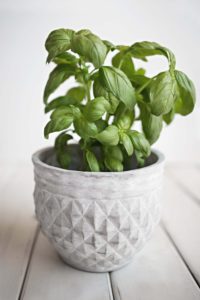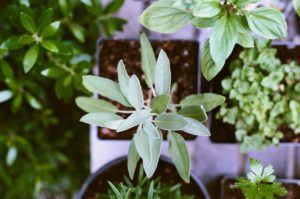Plan a Culinary Herb Garden for Spring
go.ncsu.edu/readext?593821
en Español / em Português
El inglés es el idioma de control de esta página. En la medida en que haya algún conflicto entre la traducción al inglés y la traducción, el inglés prevalece.
Al hacer clic en el enlace de traducción se activa un servicio de traducción gratuito para convertir la página al español. Al igual que con cualquier traducción por Internet, la conversión no es sensible al contexto y puede que no traduzca el texto en su significado original. NC State Extension no garantiza la exactitud del texto traducido. Por favor, tenga en cuenta que algunas aplicaciones y/o servicios pueden no funcionar como se espera cuando se traducen.
Português
Inglês é o idioma de controle desta página. Na medida que haja algum conflito entre o texto original em Inglês e a tradução, o Inglês prevalece.
Ao clicar no link de tradução, um serviço gratuito de tradução será ativado para converter a página para o Português. Como em qualquer tradução pela internet, a conversão não é sensivel ao contexto e pode não ocorrer a tradução para o significado orginal. O serviço de Extensão da Carolina do Norte (NC State Extension) não garante a exatidão do texto traduzido. Por favor, observe que algumas funções ou serviços podem não funcionar como esperado após a tradução.
English
English is the controlling language of this page. To the extent there is any conflict between the English text and the translation, English controls.
Clicking on the translation link activates a free translation service to convert the page to Spanish. As with any Internet translation, the conversion is not context-sensitive and may not translate the text to its original meaning. NC State Extension does not guarantee the accuracy of the translated text. Please note that some applications and/or services may not function as expected when translated.
Collapse ▲Planting a culinary herb garden is an aromatic and delicious way to bring in spring. The secret to transforming easy dishes into extraordinary meals is fresh herbs. Herbs also make beautiful garnishes and bouquets.
Land isn’t a requirement for an herb garden, as many herbs are suitable for container gardening. If you’ve never started seeds before, you may be more successful initially starting with transplants. The last projected frost date for Caldwell County is around April 16th, so herbs should be planted after then to avoid losing to a late freeze. However, containers could be brought inside for protection.
Cutting herbs in the morning before the sun gets hot is the best time. You can help them maintain their flavor by pinching out any flower heads that begin to develop.
They can be stored for several days in the refrigerator in a plastic bag. Keep it open or make holes in the bag for air circulation. You want to wash herbs right before using them.
If a recipe calls for dried herbs, use three times the amount of fresh. When getting ready to chop, you can include some of the tender stems with delicate herbs, such as parsley, cilantro, and basil. But with sturdy stemmed herbs, such as rosemary, thyme and oregano, remove the leaves by running your thumb and index finger down the opposite direction the leaves have grown.
To chop, bunch the leaves on a cutting board and then use a sharp chef’s knife to not bruise the leaves, rocking back and forth.
Basil, chives, cilantro, dill leaves, mint and parsley should be added the last minute or two of cooking or sprinkled on food just before serving. Oregano, rosemary, sage and thyme may be added the last 20 minutes or so of cooking.
Here are some ideas to help you start combining fresh herbs with your foods:
 Basil is a favorite and makes a great pesto. Pesto may be used as a pizza spread, sandwich spread, as a salad dressing ingredient, as a topping for bread, as a topping for salmon and other fish, and is great tossed in pasta. Basil is a natural snipped in with tomatoes and great in pasta sauce, and zucchini.
Basil is a favorite and makes a great pesto. Pesto may be used as a pizza spread, sandwich spread, as a salad dressing ingredient, as a topping for bread, as a topping for salmon and other fish, and is great tossed in pasta. Basil is a natural snipped in with tomatoes and great in pasta sauce, and zucchini.
Italian parsley is more strongly flavored and preferred for cooking than curly leaf parsley. Great in potato salad and tabouli. Makes wonderful pesto that may be stirred in pasta salads and used as a topping for fish.
Mint tastes great on carrots, fruit salads, and in tea.
Cilantro is often used in Mexican, Asian and Caribbean dishes. Common in salsa and guacamole.
Rosemary is wonderful on chicken, fish, pork, on roasted potatoes, in soups and stews and tomatoes.
Sage is most known for poultry seasoning and stuffing.
Oregano is often in Italian food, great on peppers and tomatoes.
This simple, fresh tasting recipe uses several herbs. Quinoa or rice could be substituted for the couscous.
Whole-Wheat Couscous Salad with Fresh Herbs and Dried Fruit
1 ½ cup whole-wheat couscous
3 cups chicken stock or water
3 tablespoons canola or olive oil
¼ cup chopped parsley
½ cup chopped mint
¼ cup chopped cilantro
8 – 10 dried apricots, diced
¼ cups currants or dried cranberries
¼ cup toasted pistachios or other nut of choice
Zest of juice of 1 ½ lemons
Freshly ground pepper and salt to taste
Heat the stock or water to boiling. Add canola or olive oil and salt to taste. Pour in couscous and stir. Simmer for 2 or 3 minutes, then cover and take off the heat. Let stand for 10 minutes and then fluff with a fork.
Add the remaining ingredients and adjust salt and pepper to taste.





